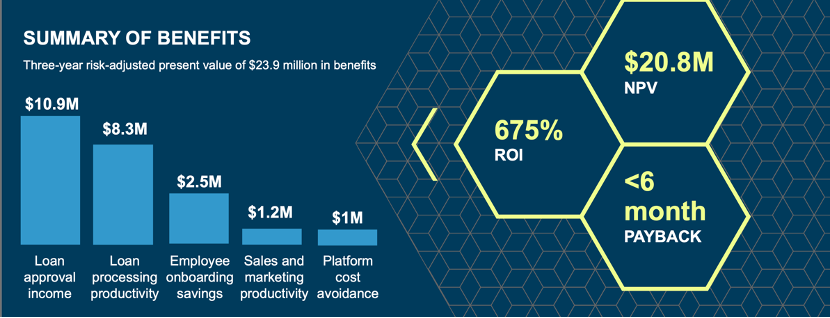Organizations need to apply specialized data-mining algorithms to fully grasp actual workflows done by employees and pinpoint areas where automation can yield the biggest process improvements.
This is pertinent amid heightened interest in automating business operations and processes, as enterprises aim to reduce manual tasks and better optimize their human resources in the global pandemic.
The financial services sector in Asia-Pacific, for instance, is projected to spend US$271 million on RPA (robotic process automation) software in 2024. According to IDC, this figure will account for at least 31% of total RPA spending in the region. Gartner also expects demand to fuel double-digital growth rates for the global RPA market over the next three years. By 2022, 90% of large enterprises will adopt RPA in some form, the research firm estimates.
Beyond RPA, intelligent automation can be applied across various business processes including content, decision making, and workflows, to improve process quality, productivity, and response.
However, workflows and business operations are increasingly complex with increased interconnectivity and digitalization. This means enterprises will find it challenging to fully understand what all the different processes mean, how they interact with each other, and what is needed to plug any inefficiencies.
Key to an organization's success in automation is process mining, which helps quantify inefficiencies in operational models and enables business leaders to make objective decisions about resource allocation.
Trial: Automate Business and IT Processes at Scale with IBM RPA
Access this page to try IBM Robotic Process Automation as a Service at no cost for 30 days to help learn how to build and run software bots or virtual agents in our single, low-code authoring environment.
Download NowSpecifically, it details how enterprises apply specialized data-mining algorithms to processes, cases, and events logged by their business applications, so they can fully grasp actual work carried out by their employees.
With process mining, businesses will uncover hidden bottlenecks and identify where automation can bring the biggest process improvements. The ability to determine where these bottlenecks are can drive down costs and help fuel innovation and service quality.
To ensure their process mining can yield more impactful results, organizations will first need to ensure they can discover, merge, and access quality data. This can be challenging as many companies struggle to pull data from disparate sources and across multiple locations.
Process mining also can be hindered by concept drift, in which processes can change even as they are being analyzed.
Integrating process mining and redefining industry use cases
The IBM Cloud Pak for Business Automation comprises various applications that help you design, build, and run intelligent automation services and applications on any cloud, using low-code authoring tools.
This allows you to more quickly develop and deploy automation bots. IBM works closely with myInvenio to integrate process and task mining technologies as part of the IBM Cloud Pak for Business Automation.
The tight integration enables enterprise customers to pinpoint activities that should be automated--for instance, with the use of an RPA bot--and use Business Process Modeling Notation (BPMN) diagrams from process mining, to begin documenting "to-be" processes.
They also can import BPMN diagrams from process mining into workflows as a skeleton automated workflow as well as apply artificial intelligence (AI) and machine learning around mining results to identify patterns and provide suggested next steps.
Process mining techniques have been used to enhance process flows for companies across multiple verticals, including finance, healthcare, manufacturing, and e-commerce. Financial institutions, for instance, have tapped process mining software to improve inter-organizational processes and audit accounts, while e-commerce marketplaces use such tools to gain insights into buyer behaviors and provide more accurate recommendations to increase sales.

Source: IBM Process mining: Easily discover and model processes
One such use case demonstrates how banks can leverage IBM's process mining solution to map and simulate an account closure process. The goal here is to increase the level of automation and improve the performance of this process, hence, reducing operational costs.
It reveals how process mining can help identify bottlenecks across the entire process, including the use of task mining to glean deeper analysis of user interaction. For example, it shows paths that take the longest to complete or that are taken most frequently, which may suggest areas where automation, when applied, can yield the greatest benefits.
The IBM solution then offers recommendations of the best RPA strategy to adopt and enables the customer to run simulations to assess how the process will perform after automation has been applied. A quick demo of this is available here.
Cut manual processes and simplify workflow
PNC Financial Services Group, for one, was able to automate 50 business processes and implement more than 5 million automated business rules by combining IBM Business Automation Workflow and IBM Operational Decision Manager--two additional offerings under IBM Cloud Pak for Business Automation.
Collectively, these bring together data, processes, and users to help organizations automate digital workflows on-premises or on cloud. They can create workflows that better facilitate collaboration between teams and improve employee productivity.
The IBM solutions helped PNC Financial cut the number of loan applications it had to review manually by 80% to 90%. The US bank also was able to increase work volumes without adding staff. Furthermore, increased visibility of its workflow helped simplify the bank's compliance reporting processes.
IBM's automation tools have helped others such as PNC Financial achieve significant gains in productivity and operational efficiencies.
According to a Total Economic Impact study by Forrester Consulting, a customer of IBM Automation Platform was able to clock benefits of almost US$23.9 million over three years, with a 675% returns on investment. This customer saved more than 200,000 hours in loan processing time each year from the implementation, with 80% of all loan applications no longer requiring manual steps and are processed automatically.

Source: The Total Economic Impact™ of the IBM Automation Platform for Digital Business
Process mining applies data science to discover, validate, and improve workflows. It plays a key part in modernizing organizations, especially as demand for automation grows across business and IT operations.
With process mining capabilities tightly integrated in IBM Cloud Pak for Business Automation, businesses can access AI-powered automation capabilities, such as prebuilt workflows, that will make every process more intelligent and accelerate their ability to innovate.
IBM solutions enable greater automation that starts with small, measurably successful initiatives, which organizations then can easily scale and optimize for other processes enterprise-wide.
Explore the power of automated algorithms to understand simple and multi-level processes, task flows and business rules with IBM Cloud Pak for Business Automation. Test drive IBM Cloud Pak for Business Automation at no cost for 14 days.

